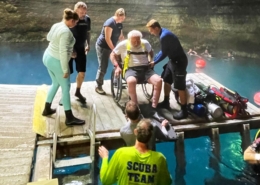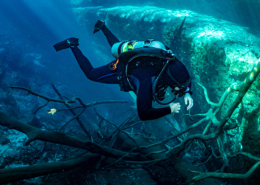Dive Travel on a Dime
By Rick Allen
There’s no denying that, no matter your economic status in life, scuba diving is an expensive pursuit. Between certifications, gear, more certifications, and upgrading to newer gear it doesn’t slow down either. Not to mention that every time I look for new places to go diving all I see are ads for liveaboards and all-inclusive resorts.
While I would love to participate in one of these swanky scuba outings at some point, they’re not exactly within my budget. The truth is, these big-ticket dive packages aren’t your only travel options. With a little effort, I’ve managed to have an average expenditure of $125 USD per day when I’m fortunate enough to go on holiday. Let me explain how I do it.
You are your own travel agent in this scenario.
Being your own agent is both the number one advantage and disadvantage to this approach. The good news is, you control all of the planning. The bad news is, there’s no one-stop-shop where you can have all of your questions answered and arrangements made. Communications with dive operators on the other side of the world will need to have time change factored in. Expect there to be at least twelve hours between any messages.
You’ll also need to double check the accuracy of any exchange rates and make sure you’re getting a fair offer. Be ready to negotiate. It’s pretty common for some dive operators to offer discounts for committing to multiple days of diving or bringing your own gear. In Southeast Asia for example, I’ve found there to be an average of $75-$90 USD per day for three tanks of diving.
The same goes for hotels and any other excursions you may hope to fit in. It’s up to you to do a thorough online search and find out what’s available at your destination. Keep in mind that many local businesses on small islands don’t have a website or Yelp review for you to browse. This is where social media can come in handy.
Do a hashtag search for your destination and see what comes up. Some hip Instagram influencer who was just on a photo shoot in Indonesia may have stumbled upon a quaint new lodging or a food stall that’s been a local favorite for generations. The work you’ll put into this part of trip planning is definitely time-consuming, but it can also be a lot of fun.
Amenities? You must mean anemones. We’ve got those!
I know I’ve found accommodations within my budget when the “upgraded” room means it includes a ceiling fan. If you’re in an area that’s considered a third world country, $30 USD should be your maximum per night allowance. I’ve found rooms for rent in the Philippines for as low as $6 USD per night. You should know that some islands have a policy to shut the electricity off during daylight hours. In these cases, it doesn’t really matter if your room features AC and satellite TV. Some may refer to staying in places like this as roughing it.
I recently splurged on a $25 USD per night cabin in Malaysia that included a ceiling fan that only worked at night and a hose on the bathroom wall that served as a shower. However, it was steps from the ocean and adjacent to the dive shop. It’s kind of hard to qualify that as roughing it when I fell asleep to the peaceful sound of waves crashing along the shore each night. Just don’t forget to bring your own toilet paper.
Are meals included?
This one’s a no-brainer when it comes to saving money on dive travel. Some dive operators offer meals with their dives while others don’t. Just ask the shop what’s included in the price for a day of diving and you’ll find out if it’s part of the package or not.
One of my favorite meals was courtesy of Palawan Divers in El Nido. During our second dive each day, the boat captain and deckhands would prepare a buffet of fruit, rice, fresh grilled fish, and the most wonderful calamansi vinaigrette I’ve ever tasted.
What was really impressive is that they managed to do all of this in a small double outrigger canoe with just a propane grill hanging over the side. We’d climb back onboard, eat until our hearts were content while floating down some channel in crystal clear water. Then we would jump back in for dive three, and everything would be clean by the time we got back onboard again. All of this was included in our cost of diving. If that’s not luxury, I don’t know what is.
Eat street food like a local.
Even if the dive operator provides your meals, chances are that won’t cover every meal you need to plan for. And even if it did, no travel would be complete without sampling some of the local street food. Ask the divemasters for some tips on what’s good and cheap to eat around town. Follow in the footsteps of the late Anthony Bourdain and expand your culinary horizons. You might just find it to be as adventurous and rewarding as the diving! It’s not uncommon to find filling meals for only $10 USD and oftentimes less than $5 USD for street BBQ snacks.
Even if you were to add up items on the high end of what I’ve laid out here, you’re only looking at $130 USD per day for an amazing dive travel experience. Yes, you still have to shell out a hefty amount of cash for airfare to get there in the first place, but once you’re there you’ll quickly find that it’s not too difficult to enjoy a piece of paradise while still being budget conscious.












Ответить
Хотите присоединиться к обсуждению?Не стесняйтесь вносить свой вклад!